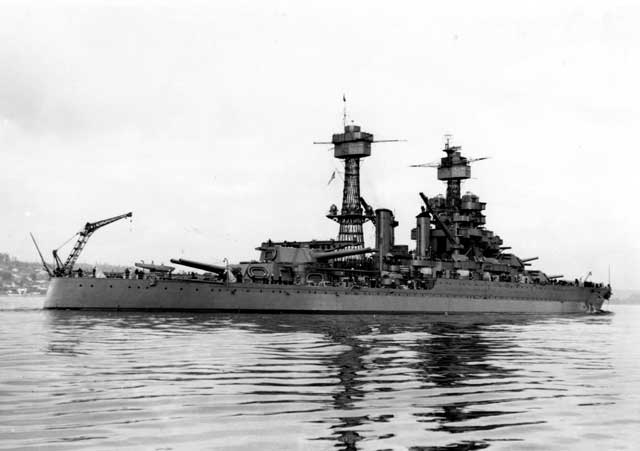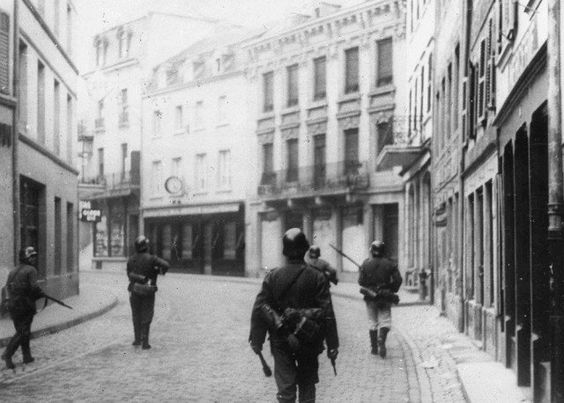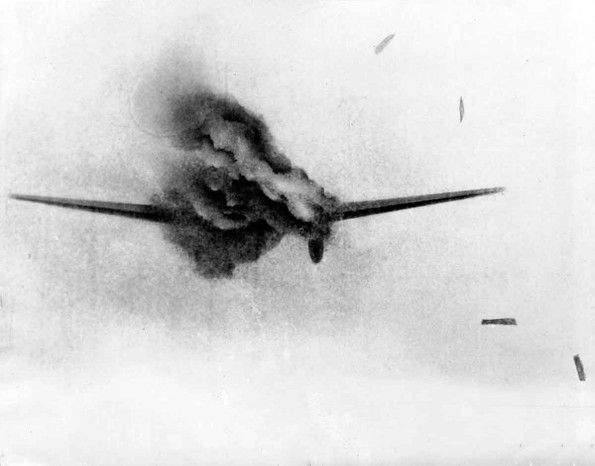Monday 9 February 1942
 |
| SS Normandie on its side after capsizing in New York Harbor on 9 February 1942. |
Battle of the Pacific: The Japanese in the early morning hours of 9 February 1942 win the Battle of Sarimbun Beach on Singapore Island, forcing the defending Australian soldiers of the 22nd Brigade to retreat. The three Australian battalions that had been defending this sector in northwest Singapore are overwhelmed as the Japanese continue pouring troops across the Strait and move back toward the center of the island. The Japanese advance out of their bridgehead and pursue the retreating Australians through several large estates. A fierce battle erupts around Tengah Airfield, with the defending Australian troops losing hundreds of men killed and hundreds more are wounded. After dark, the British send three British Fairmile B motor launches on a dangerous raid through the Straits of Johor to disrupt the Japanese communications to the troops at Sarim and succeed beyond all expectations, destroying some landing craft and returning intact to base.
 |
| SS Normandie after burning and capsizing in New York Harbor on 9 February 1942. Note the car traffic passing by, getting a good view. |
Lieutenant-General Arthur Ernest Percival, the island commander, remains convinced throughout the night that the Japanese invasion in the northwest is just a feint. He waits until mid-morning to send reinforcements, and these consist of only two half-strength battalions of the 12th Indian Infantry Brigade. Major-General Gordon Bennett, in command of the Australian troops, attempts to consolidate his forces at the Kranji-Jurong Switch Line east of Tengah Airfield - effectively ceding the airfield to the Japanese. The Japanese under General Tomoyuki Yamashita press on despite heavy casualties themselves and the Australian defensive line holds for only a few hours. This stage of the invasion is called the Battle of Kranji. At 23:00, the Japanese land troops just to the west of the causeway, and the Australian defenders quickly retreat in an effort to defend the critical southern part of Singapore. As the day ends, the Japanese are in possession of the northwestern half of the island, including the island's high ground, and the Allies' situation is chaotic but not yet completely lost.
 |
| The Lowell, Massachusetts, Sun reports in its 9 February 1942 that the "Singapore Situation Is Well In Hand." To be fair, it is only relaying the reports being sent from Singapore by Australian commander General Gordon Bennett. Of course, the map just underneath the headline shows a Japanese invasion in progress, but that is just a pesky detail everything is well in hand. |
With the Main Line of Resistance (MLR) on the Bataan Peninsula holding firm, the Allies' attacks on the Japanese pockets behind it continue to have success. In the western I Corps sector, the 1st Division, Philippine Army, eliminated the smaller of two pockets (the "Little Pocket") and joins the battle against the nearby "Big Pocket." The Japanese in the Big Pocket know they are in trouble, but their attempted breakouts fail. Far to the south, the 2d Battalion, 57th Infantry, Philippine Scouts, takes over the fight in the center of the line at the Anyasan-Silaiim pocket and makes some progress.
In the Netherlands East Indies, the Japanese land about 8000 troops near Makassar City and south of Makassar at Jeneponto on Celebes Island. They make good progress toward Makassar, taking a key bridge into the city.
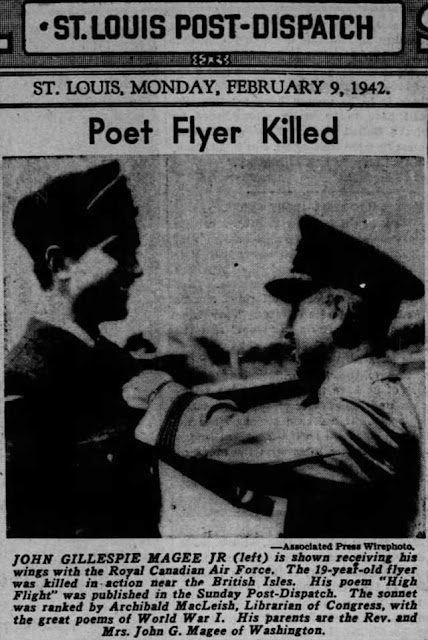 |
| The St. Louis, Missouri, Post-Dispatch notes the passing over the British Isles of "Poet Flyer" fighter pilot John Gillespie Magee, Jr. Magee, an Anglo-American volunteer with the Royal Canadian Air Force, perished on 11 December 1941 during an accidental mid-air collision. |
The USAAF Fifth Air Force is redeploying its forces over long distances, and this is not easily accomplished. A flight of planes (three 5th Air Force A-24 Dauntlesses, nine P-40s, and an LB-30 Liberator guide) from Australia to a waypoint at Koepang Airdrome on Timor encounters bad weather at the airfield. Forced to land anyway due to fuel exhaustion, all nine P-40s crash. To compound the tragedy, Dutch anti-aircraft gunners at the airfield mistake the planes for Japanese attackers and shoot three A-24s down. They also damage two of the remaining three A-24s, which later are forced to return to Australia for repairs along with the LB-30. This leaves exactly one plane out of the large flight, an A-24, to continue on to the final destination on Java.
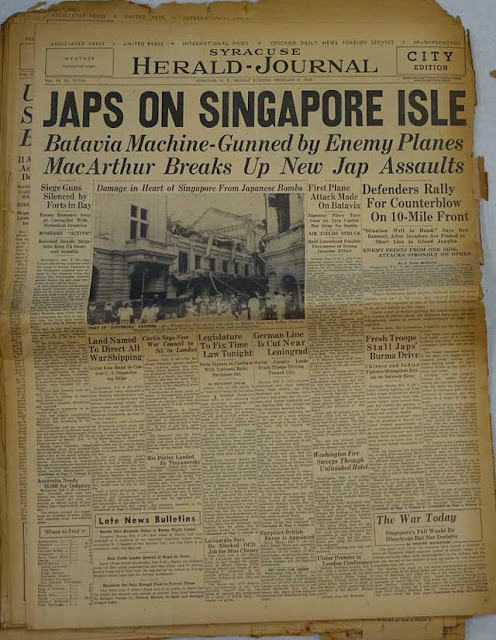 |
| The 9 February 1942 Syracuse (N.Y.) Herald-Journal correctly and quickly reports that the Japanese have invaded Singapore Island. |
US Navy submarine USS Trout (Lt.Cdr. F.W. Fenno), on its second war patrol out of Pearl Harbor, is on a secret mission to evacuate 20 tons of gold bars and silver pesos, one officer, and mail from the Philippines when she spots a Japanese gunboat about 55 nautical miles from Keelung, Formosa. Commander Fenno firest a torpedo at the gunboat and sinks it, then returns to Pearl Harbor with the gold.
Eastern Front: The Luftwaffe airlift to the encircled German garrison at Demyansk and Kholm is underway. The German troops in the larger pocket at Demyansk, II Corps, have reported that they require 300 tons of supplies every day to survive. This is a lot of supplies to ferry, considering that every Junkers Ju-52 could only carry about one ton of supplies. The transports are slow and very vulnerable to the Red Air Force fighter attack, so they have to fly in "convoys" of 20 to 40 planes with fighter cover. The airfields within the Demyansk pocket are under sustained bombing attacks, which makes landings difficult at best and sometimes impossible. In the latter situation, the cargo containers are dropped through the bomb bay doors with parachutes and sometimes drift into enemy territory. Early indications are that the airlift will never reach its goal of 300 tons of supplies, but may barely carry enough to keep the soldiers fighting until they can be relieved.
European Air Operations: There are no major operations today due to winter weather conditions.
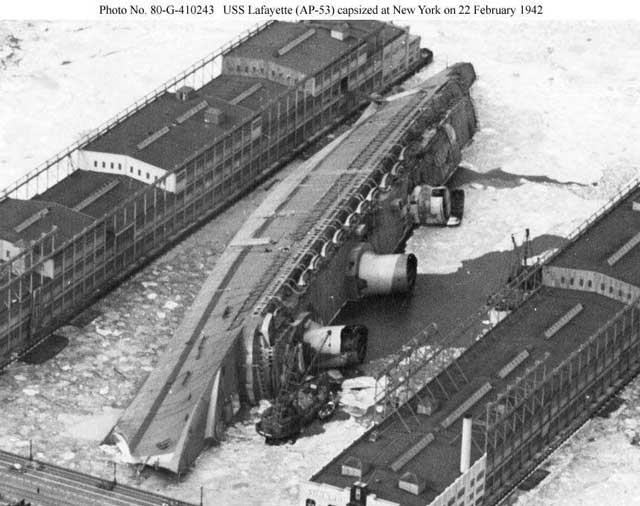 |
| SS Normandie after catching fire and capsizing on 9 February 1942 (US Navy). |
Battle of the Atlantic: The 83,423-ton French ocean liner SS Normandie, which has been seized by US authorities and renamed USS Lafayette, suddenly catches fire while being converted to a troopship at her berth in upper Manhattan. After a long fight by local firefighters, Normandie capsizes in the shallow water next to the dock. After salvaging her, the US Navy decides that the ship is too costly to restore. SS Normandie, having sat idle throughout the war, is sold as scrap on 3 October 1946. The scrapping is completed by 31 December 1948. The Normandie, launched in 1932, is 1029-feet long and the first vessel laid in compliance with the 1929 SOLAS Convention (Safety of Life at Sea).
U-654 (Oblt. Ludwig Forster), on its second patrol out of Brest, torpedoes and sinks Free French corvette Alysse in the western Atlantic. There are 34 deaths.
U-586 (Oblt. Dietrich von der Esch), on its first patrol out of Kiel, torpedoes and damages 9057-ton Norwegian tanker Anna Knudsen north of Scotland. The tanker makes it to port with the assistance of a tug.
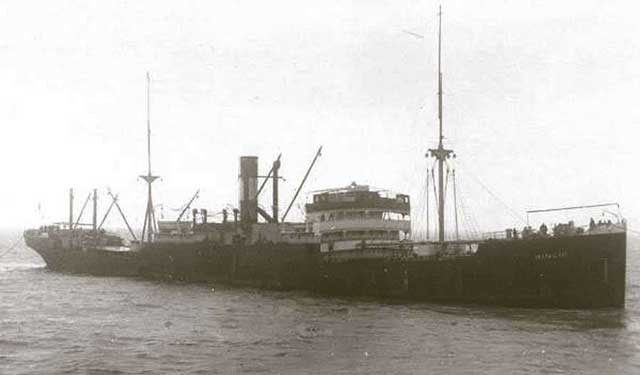 |
| British freighter SS Empire Fusilier, sunk by U-85 on 9 February 1942. |
U-85 (Oblt. Eberhard Greger), on its third patrol out of Lorient, torpedoes and sinks 5408-ton British freighter Empire Fusilier southeast of St. John's, Newfoundland. The freighter was part of Convoy ON-60 but has been dispersed. There are nine deaths and 38 survivors.
U-108 (KrvKpt. Klaus Scholtz), on its sixth patrol out of Lorient, torpedoes and sinks 1974-ton Norwegian freighter Tolosa off the North Carolina coast. All 22 crew perish.
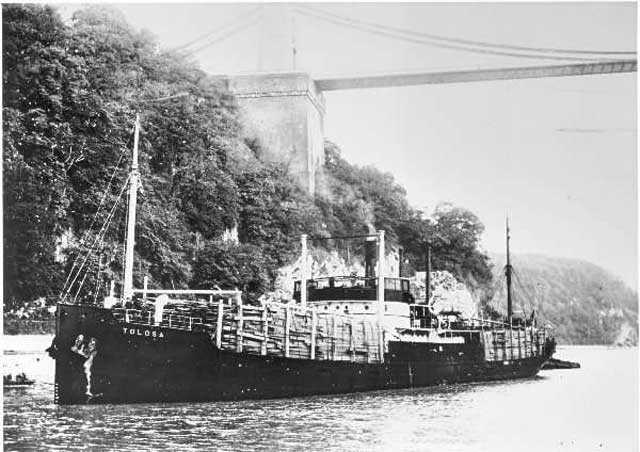 |
| SS Tolosa, sunk by U-108 on 9 February 1942 with no survivors. |
At Brest, Occupied France, the ships that are scheduled to participate in the Channel Dash, Operation Cerberus, complete their sea trials after being inactive for a year. With everything now ready for the breakout through the English Channel, the date for departure is confirmed for the evening of 11 February 1942. The Germans know that there are many spies in town, so they practice a disinformation campaign by loading the ships with oil barrels marked "For use in the Tropics" and tropical helmets. This deception works exceedingly well, and while locals can easily surmise that the ships are departing, the local spies never alert the British Admiralty that the ships will be heading north.
 |
| Free French corvette Alysse, sunk by U-654 on 9 February 1942. |
Battle of the Mediterranean: The two sides have settled down to garrison duty in Libya, but fighting continues off the coast. Luftwaffe planes attack convoy AT-27 near Mersa Matruh and damage Royal Navy escort destroyer HMS Farndale. The Farndale makes it back to Alexandria in tow.
War Crimes: At Makassar City, a company of native soldiers takes a Japanese unit by surprise at a bridge they have captured and inflict numerous casualties. In reprisal, the Japanese take the Dutch prisoners they have taken at the bridge, tie them together in groups of three, and throw them off the bridge to drown. This is the Makassar Massacre.
 |
| A12 infantry tank Mk II "Matilda" II comes ashore from a landing craft during combined operations training involving the 5th New Zealand Infantry Brigade at Ras Sudr in Egypt, 9 February 1942. |
Chinese/British Relations: Chiang Kai-shek and his wife, Madame Chiang, make a somewhat hazardous trip to India for a 13-day visit. This visit helps to mend some of the bad feelings between the two Allies that have arisen from their conflicting claims on U.S. lend-lease supplies in Burma.
Allied Relations: The Pacific War Council, composed of representatives from the U.K., Australia, Netherlands East Indies, and New Zealand, is formed in London. This complements the American-British-Dutch-Australian military command (ABDACOM). The United States is not yet a member but will become one on 1 April 1942.
 |
| Time magazine of 9 February 1942, featuring Robert A. Lovett on the cover (Ernest Hamlin Baker). Lovett is an assistant secretary of war for air and oversees the massive expansion of the US Army Air Forces. |
US Military: The 78th Pursuit Group (Interceptor) and its three subordinate units, the 82d, 83d and 84th Pursuit Squadrons (Interceptor), USAAF, are activated at Baer Field, Fort Wayne, Indiana. This will become the 78th Fighter Group later in 1942 and eventually serve in the European Theater of Operations.
The 30th Bombardment Group (Heavy), 28th Composite Group, transfers its B-18 Bolo bombers from Elmendorf Field to Ft Greeley, Kodiak. These 1936 bombers are considered almost obsolete and soon are relegated to antisubmarine, transport duty, and training.
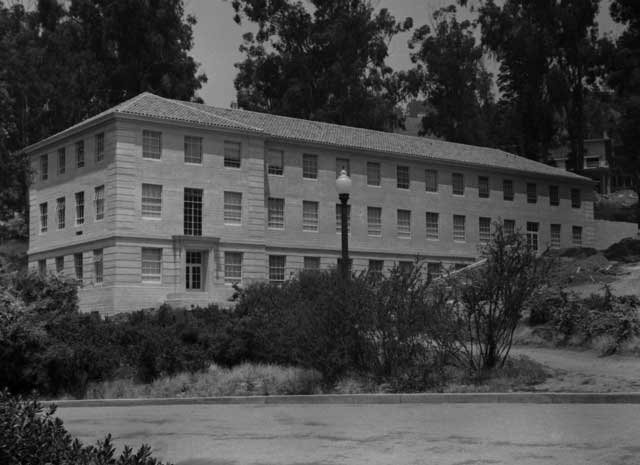 |
| Medical Physics Building (Donner Lab) at Berkeley Lab, taken February 9, 1942. (US National Archives). |
Finland: Lauri Kristian Relander, the 2nd President of Finland 1925-1931, passes away from heart failure at the age of 58.
Canada: In four by-elections, candidates opposed to conscription are defeated.
American Homefront: Congress imposes daylight saving time by pushing ahead standard time by one hour in each time zone. This is known as "War Time." The idea originated in New Zealand in the 19th Century, was used by both sides during World War I, and is based on a theory that more daylight in the morning aids efficiency and saves on energy costs. In addition, Congress also standardizes timekeeping throughout the United States by establishing five time zones. This law standardizing time remains in effect throughout World War II but is repealed shortly afterward. It is resuscitated in 1966 with the Uniform Time Act, which establishes daylight saving time from the last Sunday in April to the last Sunday in October.
 |
| Newsweek magazine, 9 February 1942. |
Future History: Carol Joan Klein is born in New York City, New York. Carol begins taking music lessons at the age of four, then forms a band at James Madison High School called the Co-Sines. At this time she changes her name to Carole King. Her first recording, "The Right Girl," is in 1958. At Queens College, Carol meets and marries Gerry Goffin, and together they form a songwriting partnership. Carole's friend Neil Sedaka writes a song about her called "Oh! Carol" which becomes a minor hit, and not long after that Carole King and Gerry Goffin write "Will You Love Me Tomorrow," which becomes a No. 1 hit for the Shirelles. After this, the duo writes a string of classic hits, including "One Fine Day" for the Chiffons, "Up on the Roof" by the Drifters, and "Pleasant Valley Sunday" for the Monkees. After getting divorced, Carole King goes on to a legendary solo composing and singing career with her No. 1 album "Tapestry" winning four Grammy awards and becoming one of the rock era's classic recordings. Carole King goes on to a long and successful musical career and remains active as of this writing in the 21st Century.
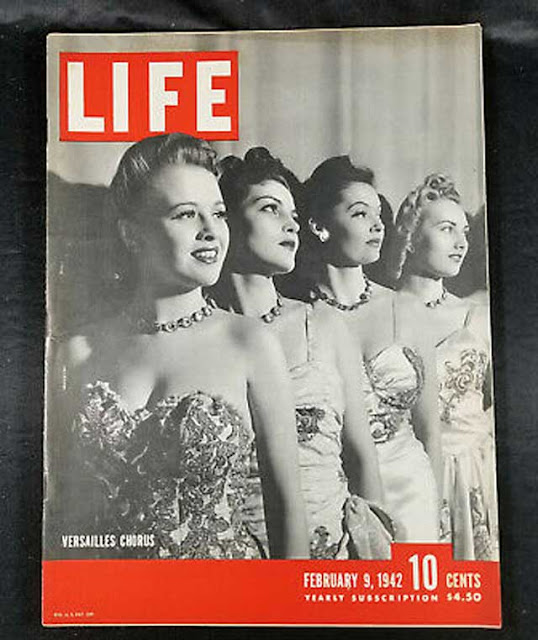 |
| Life magazine, 9 February 1942, featuring the Versailles Chorus (from a feature on nightclubs) on the cover. |
February 1942February 1, 1942: The US Navy Strikes BackFebruary 2, 1942: Germans Recovering in RussiaFebruary 3, 1942: Japanese Shell and Bomb SingaporeFebruary 4, 1942: Battle of Makassar StraitFebruary 5, 1942: Empress of Asia SunkFebruary 6, 1942: The Christmas Island BodyFebruary 7, 1942: The Double-V CampaignFebruary 8, 1942: Japan Invades SingaporeFebruary 9, 1942: French Liner Normandie CapsizesFebruary 10, 1942: US Car Production EndsFebruary 11, 1942: Tomforce Fails on SingaporeFebruary 12, 1942: The Channel DashFebruary 13, 1942: Japanese Paratroopers In ActionFebruary 14, 1942: RAF Orders Terror RaidsFebruary 15, 1942: Japan Takes Singapore
February 17, 1942: Indian Troops Defect to JapaneseFebruary 18, 1942: Battle of Badung StraitFebruary 19, 1942: FDR Authorizes Internment CampsFebruary 20, 1942: O'Hare the HeroFebruary 21, 1942: Crisis in BurmaFebruary 22, 1942: Bomber Harris Takes OverFebruary 23, 1942: Bombardment of Ellwood, CaliforniaFebruary 24, 1942: US Raid on Wake IslandFebruary 25, 1942: Battle of Los AngelesFebruary 26, 1942: Gneisenau EliminatedFebruary 27, 1942: Battle of Java SeaFebruary 28, 1942: Battle of Sunda Strait2020



